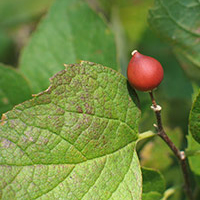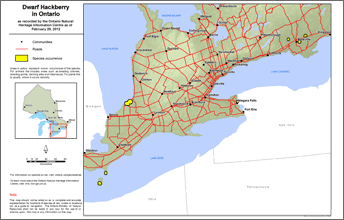Dwarf hackberry
Scientific name: Celtis tenuifolia

Cover photo credit: Allen Woodliffe
Status
Threatened
“Threatened” means the species lives in the wild in Ontario, is not endangered, but is likely to become endangered if steps are not taken to address factors threatening it.
Date added to the Species at Risk in Ontario List
The Dwarf Hackberry was already assessed as threatened when the Endangered Species Act took effect in 2008.
What it looks like
Dwarf Hackberry is a small tree that usually grows one to four metres high, but can reach up to 10 metres. The bark is light grey and becomes ridged with age.
The leaves are broadly oval at the base and taper to a point at the tip. The edge of the leaves can have few or many teeth. The round, orange fruits are sweet and sugary and are eaten by birds and mammals.
Where it lives
Dwarf Hackberry grows in several different habitats. These include dry, sandy areas near lakeshores, inland dunes, ridge tops and limestone alvars.
Several plant communities in which Dwarf Hackberry occurs are considered rare to extremely rare, such as shrub and treed sand dunes, oak savannas, and red cedar-treed alvars.
Dwarf Hackberry is a sun-loving tree that does best in areas where it will not be shaded-out by other trees and vegetation.
Where it’s been found in Ontario
The species reaches the northern limits of its distribution in southern Ontario, over 1,000 kilometres north of the geographical centre of its range in the United States.
In Canada, there are six known locations in southern Ontario: Port Franks area, Point Pelee, Pelee Island, Point Anne, and two sites near Belleville. The Canadian population is estimated to be more than 14,000 plants.
View a larger version of this map (PDF)
What threatens it
The main threats to Dwarf Hackberry are aggregate extraction, development, logging and altered disturbance regimes (e.g. fire frequency, coastal processes, wind, disease) that normally limit habitat succession by plants that will shade out this sun-loving species.
They are also at risk from bark beetles, snails, deer, as well as invasive and allelopathic plants. Allelopathic plants release a substance into the environment that inhibits the germination or growth of other potential competitor plants of the same or another species.
Action we are taking
Threatened Species and their general habitat are automatically protected
Recovery strategy
A recovery strategy advises the ministry on ways to ensure healthy numbers of the species return to Ontario.
Read the executive summary (May 31, 2013)
Read the recovery strategy (May 31, 2013)
Government response statement
A government response statement outlines the actions the government intends to take or support to help recover the species.
Read the government response statement (March 14, 2014)
Review of progress
A review of progress made toward protecting and recovering a species is required no later than the time specified in the species’ government response statement, or not later than five years after the government response statement is published if no time is specified.
Read the report on progress towards the protection and recovery of 16 species at risk, including Dwarf Hackberry (Celtis tenuifolia) (2019).
Habitat protection
General Habitat Protection - June 30, 2013
What you can do
Report a sighting
- Report a sighting of an endangered animal or plant to the Natural Heritage Information Centre. Photographs with specific locations or mapping coordinates are always helpful.
Volunteer
- Volunteer with your local nature club or provincial park to participate in surveys or stewardship work focused on species at risk.
Be a good steward
- Private land owners have a very important role to play in species recovery. If you find Dwarf Hackberry on your land, you may be eligible for stewardship programs that support the protection and recovery of species at risk and their habitats.
- Invasive species seriously threaten many of Ontario’s species at risk. To learn what you can do to help reduce the threat of invasive species, visit:
- Consult the Ministry of Natural Resources and Forestry when working around forests for information on provincial regulations and best management practices to protect these important habitats. Call toll free
1-800-667-1940 .
Report illegal activity
- Report any illegal activity related to plants and wildlife to
1-877-TIP-SMNR (847-7667) .
Quick facts
- Dwarf Hackberry’s scientific name tenuifolia means "with thin leaves" in Latin, but the leaves are actually quite stiff and leathery.
- Many insects rely on the Dwarf Hackberry for survival. Several rare insects, including beetles that were only recently discovered in Canada, also depend on the Dwarf Hackberry for part of their life cycles.
